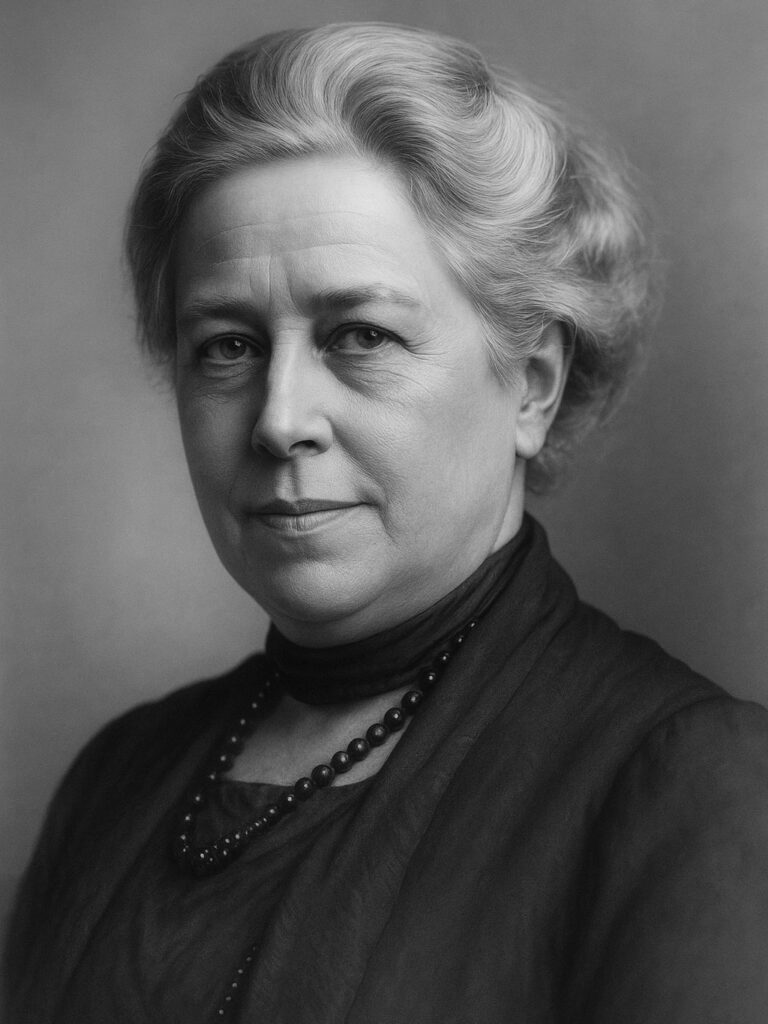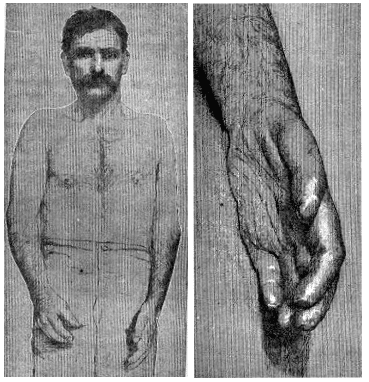Augusta Klumpke

Augusta Déjerine-Klumpke (1859-1927) was an American neurologist
First woman in France to receive the title of ‘interne des hôpitaux’ and the first female President of the Societé de neurologie de Paris.
In World War I, Déjerine-Klumpke pioneered the rehabilitation of soldiers with injuries to the spinal cord in 300 bed unit at the Saltpêtrière Hospital.
Klumpke is best known for her 1885 description of lower radicular palsy with oculopupillary phenomena, better known as Klumpke palsy
In addition she described heterotopic calcification after spinal cord injury; and provided an analysis of the pathological anatomy associated with polyneuritis, especially that for lead neuropathy. Her contribution to many aspects of neurology and neuroanatomy is regarded as pioneering to this day.
Biography
- Born Augusta Klumpke on October, 15 1859 in San Francisco, California
- 1871 – Moved to Europe with her mother and siblings in search of medical assistance for her sister, who was unwell with osteomyelitis. Later, her mother moved the family to Europe permanently and later to Paris in search of opportunities in higher education for her children.
- 1877 – Commenced medical studies at the Faculty of Medicine, Paris in addition to science courses at the Sorbonne. Klumpke persisted with her studies despite opposition to the education of women in medicine. Indeed, the Dean of the Faculty, Prof E.F.A. Vulpian, encouraged her to seek a more traditional occupation:
There are political figures who favor the emancipation of women. I do not share their opinion. I reiterate that the role of a woman is to create a home and to devote herself to her husband and her children.
Vulpian 1883
- 1880 – Stagiaire at the Hôpital de la Charité, Paris, under Professor Hardy. “I read original papers, consulted textbooks and compared published observations with inpatients in our service. I was instructing myself and shaping my mind. These years were far more interesting than the mere study of books for preparing an examination”
- 1881 – The externship was the first step toward a career in academic medicine. The coveted post was awarded to a select few “male” medical students each year and, awarded on the basis of a public competition, examination, and sponsorship by members of the Faculty of Medicine. Following an unyielding campaign by English woman, Blanche Edwards (1858–1941), the Paris externship competition was finally opened to women.
- 1883 – Externship at the Hôtel-Dieu, Paris. Klumpke and Edwards were the first women accepted for externship and named Externes des Hôpitaux de Paris.
- 1885 – Thesis: ‘Des polynévrites en général etdes paralysies et atrophies saturnines en particulier. Etude clinique et anatomo-pathologique.’ Research on brachial plexopathies describing the pattern of injury to the nerves in the lower trunk of the brachial plexus and the association of these injuries with Horner syndrome
- 1886 – Awarded Le prix Gôdard de l’Académie de Médecine for her work on Klumpke paralysis
- 1888 – Married French neurologist Jules-Joseph Dejerine (1849 – 1917). Together they co-authored a 2-volume book Anatomie des Centres Nerveux (Anatomy of the Central Nervous System)
- 1889 – MD. Thèse de médecine de Paris n° 383: Des polynévrites en général et des paralysies et atrophies saturnines en particulier
- 1914 – President of the Societé de neurologie de Paris (First female president)
- 1917 – Following the death of her husband, Augusta continued much of his practice and research. To inspire and encourage the younger generation she established an annual award, in memory of Jules-Joseph Dejerine, for clinical and experimental anatomy in association with the Society of Neurology.
- 1924 – She was awarded the Officier de la Légion d’honneur and Chevalier de la Légion d’honneur for her work in rehabilitation at the Hôtel national des Invalides (Paris, France)
- Died on November 5, 1927 in Paris, France aged 68 years old of breast cancer.
Medical Eponyms
Klumpke palsy (1885)
Lower trunk brachial plexopathy associated with hand weakness, usually accompanied by Horner syndrome. Typical mechanism of injury is traction of the arm with the shoulder abducted and the elbow extended.
Klumpke examined cases of varying degrees of brachial plexus paralysis and conducted her own experiments in Vulpian’s laboratory at the Hôtel-Dieu. Her published work on the “Contribution à l’étude des paralysies radiculaires du plexus brachial” was awarded the 1886 Gôdard Prize by the French Academy of Medicine.
Contrary to popular opinion, Klumpke’s careful review of multiple cases, revealed that lesions involving a proximal injury to the nerve roots of the lower plexus (radicular paralyses), were accompanied by oculopupillary phenomena (Horner syndrome)
…une symptôme pathognomonique pour ainsi dire des paralysies radiculaires inférieures, symptômes que Ton ne retrouve pas dans les paralysies totales évoluant vers le type Duchenne-Erb: ce sont des phénomènes oculo-pupillaires…Or pour nous, les paralysies radiculaires seules s’accompagnent de phénomènes oculo-pupillaires.
Ces phénomènes, qui sont constants dans toute paralysie véritablement radiculaire inférieure, sont caractérisés par du myosis, par le rétrécissement de la fente palpébrale, et dans quelques cas par la petitesse et la rétraction du globe oculaire. Dans 3 observations on a, de plus, noté {‘aplatissement de la joue du côté correspondant à la paralysie.
Klumpke 1885: 597-598
Oculopupillary phenomena are a pathognomonic symptom of lower radicular palsy, that one does not find in total paralysis of the brachial plexus such as the Duchenne-Erb type. In our opinion, only radicular paralyses are accompanied by oculopupillary phenomena.
These phenomena, which are constant in all true lower radicular paralyses, are characterized by myosis, by a stricture of the palpebral fissure, and, in some cases, by the smallness and the retraction of the eyeball. In three observations, we have, in addition, noted a flattening of the cheek on the side affected by the paralysis.
Klumpke 1885: 597-598

Klumpke was able to prove experimentally that the lesion causing the oculopupillary phenomena was at the rami communicantes rather than a lesion in the cervical portion of the sympathetic system. Klumpke severed the brachial plexus at various levels in dogs. She was able to recreate the oculopupillary phenomenon by cutting the C8 and/or T1 nerve root at the level of the intervertebral foramina.
Major Publications
- Klumpke A. Contribution à l’étude des paralysies radiculaires du plexus brachial. Paralysies radiculaires totales. Paralysies radiculaires inférieures. De la participation des filéts sympathiques oculo-pupillaires dans ces paralysies. Revue de médecine (Paris). 1885; 5: 591-616; 739-790
- Déjerine-Klumpke A. Des polynévrites en général, et des paralysies et atrophies saturnines en particulier. 1889
- Déjerine J, Déjerine-Klumpke A. Anatomie des centres nerveux. 1895 [1901 Tome II]
- Dejerine-Klumpke A, Jumentié J. Contribution à l’étude des fibres aberrantes de la voie pédonculaire dans son trajet pontin. Les faisceaux aberrants bulbo-protubérantiels internes et externes. Fascicules aberrants médio-pontins. Pes lemniscus interne. Revue Neurologique 1910; 20: 385–98.
- Dejerine J, Dejerine-Klumpke A, Jumentié MJ. Sur l’Etat de la Moelle Epinière dans Les Cas de Paraplégie avec Troubles Dissociés. Contribution à l’Etude du Trajet de Certains Faisceaux Médullaires et Syndrome des Fibres Radiculaires Longues des Cornes Postérieures. Revue Neurologique 1914; 15: 54-61.
- Dejerine J, Dejerine-Klumpke A, Mouzon J. Sur l’Etat des Réflexes dans les Sections Complètes de la Moelle Epinière. Revue Neurologique 1914; 15: 155 -163.
- Dejerine-Klumpke A, Ceillier MA. Trois cas d’Ostéomes-Ossifications Périostées Juxta-Musculaires et Interfasciculaires, chez des Paraplégiques par Lésion traumatique de la Molle Epinière des Paraplégiques. Revue Neurologique, 1918; 159-172.
- Dejerine-Klumpke A, Ceillier MA. Para-arthropathies du Genou chez les Paraplégiques. Revue Neurologique, 1918; 2(7-8): 348-356.
- Dejerine-Klumpke A, Ceillier MA. Paraosteoarthropathies des Parapleégiques par Lésion Médullaire; Etude Clinique et Radiographique. Annales de Médecine 1918; 5: 497. [Translation: Paraosteoarthropathies of paraplegic patients by spinal cord lesion. Clinical and roentgenographic study. Clin Orthop Relat Res. 1991;(263):3-12.]
- Dejerine-Klumpke A. Discours au nom des anciens élèves de Vulpain. Revue Neurologique 1927; 6: 1112-1122.
References
Biography
- Roussy G. Madame Déjerine 1859-1924. 1929
- Cornet A, Cornet A. Une campagne de presse en faveur des candidatures féminines à l’Internat des Hôpitaux de Paris en 1884 [A press campaign during the last century in order to help women students of medicine as candidates for the “Internat des Hôpitaux de Paris”]. Hist Sci Med. 1995;29(2):117-122.
- Goetz CG. Charcot and the myth of misogyny. Neurology. 1999;52(8):1678-1686.
- Bogousslavsky J. The Klumpke family–memories by Doctor Déjerine, born Augusta Klumpke. Eur Neurol. 2005;53(3):113-20
- Ulgen BO et al. Augusta Déjerine-Klumpke, M.D. (1859-1927): a historical perspective on Klumpke’s palsy. Neurosurgery. 2008;63(2):359-367.
- Fardeau M. Jules and Augusta Dejerine: Crossing biographies. Revue Neurologique, 2017;173:S2-3
- Balakrishnan VS. Augusta Dejerine-Klumpke. Lancet Neurol. 2018; 17(11): 936.
- Thomas E, Aziz-Donnelly A, Garcia-Santibanez R. Women in the History of Neuromuscular Medicine. Neuromuscular Disorders. 2019; 29: 698-703
- Mele S, Metitieri T, Favero M. Profile of Augusta Dejerine-Klumpke. In: WiNEu, European Women in Neuroscience, Untold stories: the Women Pioneers of Neuroscience in Europe. 2017
- Bibliography. Dejerine, Augusta 1859-1927. WorldCat Identities
Eponym
- Merryman J, Varacallo M. Klumpke Palsy. StatPearls
- Sandmire HF, DeMott RK. Erb’s palsy causation: a historical perspective. Birth. 2002;29(1):52-54
- Pearce JMS. Fragments of Neurological History. 2003
- Watt AJ, Niederbichler AD, Yang LJ, Chung KC. Wilhelm Heinrich Erb, M.D. (1840 to 1921): a historical perspective on Erb’s palsy. Plast Reconstr Surg. 2007;119(7):2161-2166.
- Ulgen BO, Brumblay H, Yang LJ, Doyle SM, Chung KC. Augusta Déjerine-Klumpke, M.D. (1859-1927): a historical perspective on Klumpke’s palsy. Neurosurgery. 2008;63(2):359-367.
- Pryse-Phillips W. Companion to Clinical Neurology. 3e 2009
- McGillicuddy JE. Neonatal brachial plexus palsy – historical perspective. J Pediatr Rehabil Med. 2011;4(2):99-101.
Eponym
the person behind the name
Studied at University of Birmingham MBChB, and King's College London BSc (Psychology). British doctor working in Emergency Medicine, Perth. Special interests include elderly care, neurology and emergency medicine.

